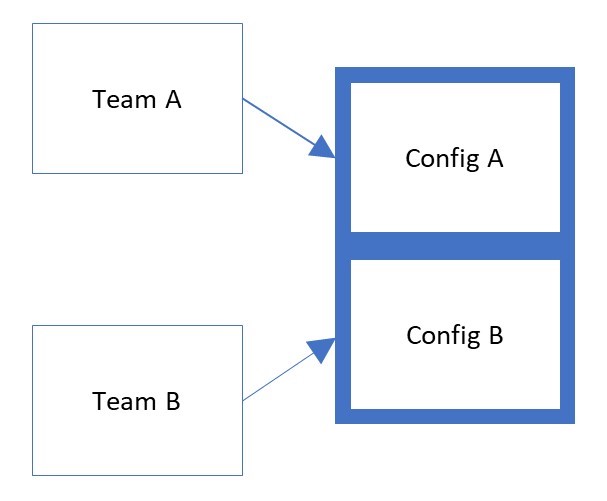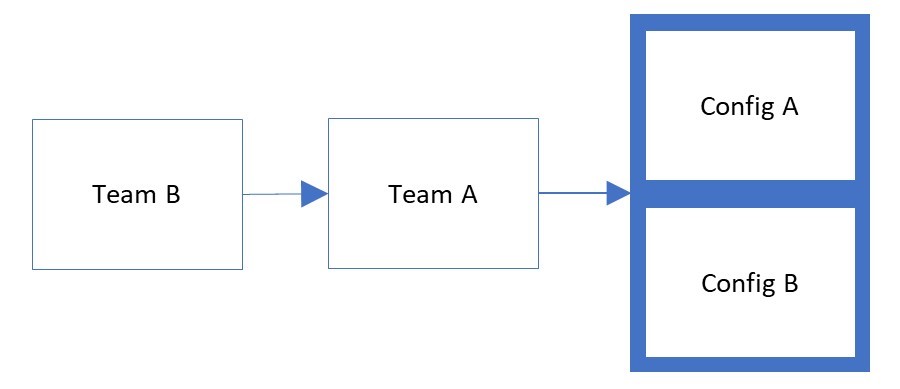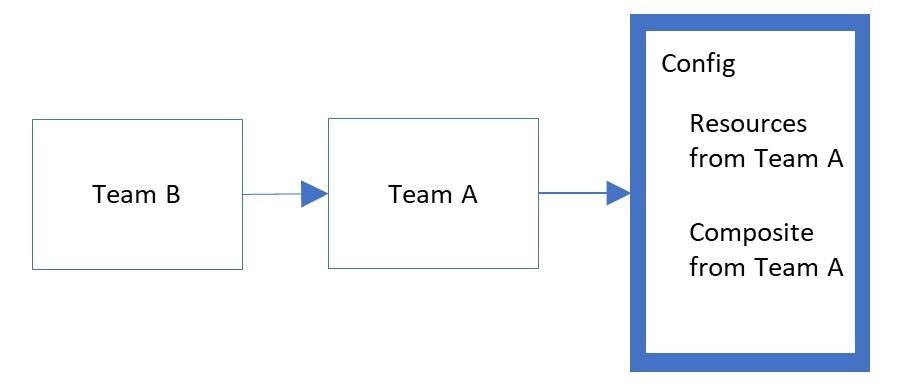Understanding DSC's role in a CI/CD pipeline
This article describes the types of approaches available for combining configurations and resources. The goal for each scenario is the same, to reduce complexity when multiple configurations are preferred to reach a server deployment end state. An example of this would be multiple teams contributing to the outcome of a server deployment, such as an application owner maintaining the application state and a central team releasing changes to security baselines. The nuances of each approach including the benefits and risks are detailed here.

Types of Collaborative Authoring Techniques
There are two solutions built in to Local Configuration Manager to enable this concept:
| Concept | Detailed Information |
|---|---|
| Partial Configurations | Documentation |
| Composite Resources | Documentation |
Understanding The Impact of Each Approach
Either of these solutions can be used to manage the outcome of a server deployment. However, there is significant difference in the impact of using each approach.
Partial Configurations
When using Partial Configurations, Local Configuration Manager is configured to manage multiple configurations independently. Configurations are compiled independently and then assigned to the node. This requires LCM to be configured in advance with the name of each configuration.

Partial Configurations provide two, or more, teams complete control over configuration of a server, often without the benefit of communication or collaboration.
Customers have provided feedback that this can lead to resource conflicts, unintentional overrides, and ultimately loss of true configuration control of the asset.
Additionally, customers have provided feedback that when using this model, each controlling teams configuration changes are unlikely to be fully tested through a release pipeline, leading to unexpected results in production.
It is critical that a single pipeline be used to evaluate all changes released to servers.
In the illustration below, Team B releases their partial configuration to Team A. Team A then runs their tests against a server with both configurations applied. In this model, only one authority has permission to make changes in production.

When changes are required from Team B, they should submit a Pull Request against Team A's source control environment. Team A would then review the changes using test automation and release to production when there is confidence that the changes will not cause errors in the applications or services hosted by the server.
Composite Resources
A composite resource is simply a DSC Configuration packaged as a resource. There are no special requirements for configuring LCM to accept composite resources. The resources are used within a new configuration and a single compilation results in one MOF file.

There are two common scenarios for composite resources. The first is to reduce complexity and abstract unique concepts. The second is to allow baselines to be packaged for an application team to safely deploy through their release pipeline to production after all tests have passed.
Configuration Name
{
File 1
{
Ensure = "Present"
Path = "c:\inetpub\file1.zip"
Source = "http://uri/file1.zip"
}
Service A
{
Ensure = "Present"
Name = "ServiceA"
Status = "Running"
}
SecurityBaseline Settings
{
Ensure = "Present"
Datacenter = "NorthAmerica"
}
}
Composite resources promote both composition and collaboration using a pipeline while building operational maturity.
You might be already using composite resources without realizing it. An example is ServiceSet. This resource manages the state of multiple Windows Services without listing them individually. The Name property accepts an array of strings to provide the name of each service. When the configuration is compiled, the MOF will contain a unique Service section for each of the Names passed to ServiceSet.
Organizations might have "agents" or "middleware" that should be installed on every server. A composite resource is the best answer to managing the dependencies, setup, and configuration of any such tools and utilities.
The person or team responsible for solutions that span multiple servers authors a configuration containing their requirements. Next, the configuration would be packaged as a composite resource using instructions provided in the composite resource documentation. Finally, the new composite resource should be published to a location such as a file share or NuGet feed where application teams can consume it in their configurations.
Each time the team releases a new version, they would increment the version number in the module manifest for their composite resource. The application teams include the composite resource in the configuration they author for managing application dependencies. When the Operations/Security teams release a new version of their resource, they notify the application teams of a new change.
The application teams might trigger a release to production where the only change is to baselines. However, this provides an opportunity to evaluate impact to applications before risk of a service outage.
Note
Feedback regarding the use of composite resources has included criticism that making changes requires compiling and releasing a new MOF. This is by design. Each new configuration release should include a static reference to a specific version of each resource, and should be validated by tests before reaching production server nodes. The process of testing and releasing changes from source control creates a safe environment for releasing change in small but frequent batches.
